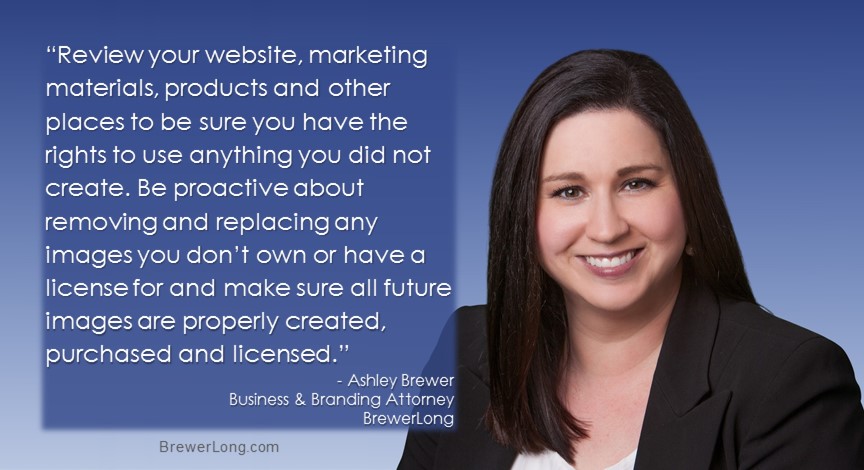
Just because an image is on Google doesn’t mean you can use it on your website or in other marketing materials
You need images for your website and other projects, such as brochures, reports, presentations, social media and so on. But original and even stock photography can be expensive.
If you’re tempted to just download what you need from the internet without paying for it, don’t. Here’s why:
- Just because it’s on the internet doesn’t mean it’s free for anyone to use. The creators of the images own the copyright and control the use. While many creators put their work out in the public domain because they want it shared as much as possible, others want to be paid or at least want to control where their work appears.
- You could be sued. The copyright owner could be entitled to recover their own damages as well as any profits you may have earned from using the image—and that’s not all. If the owner simply doesn’t like the way the image was used and feels your use diminished the value of it, they can seek statutory damages in amounts ranging from $750 to $30,000—even if they didn’t suffer any monetary loss from your use or you made no profit from it. If the court finds your infringement was willful, it can increase the statutory damage award to $150,000 and you could be liable for attorney’s fees for both yourself and the copyright owner. (See 17 U.S. Code §504)
- You may have to remove the image from wherever you have used it. It can be time-consuming and expensive to remove the image from your website, social media accounts and printed materials and replace it with something you have the right to use. If you don’t manage all the locations where you used an image, you might not be able to recover them all, putting you further at risk of liability to the owner. Even if you know where you used it, you don’t know who else may have copied it from those sources and used it.
What’s likely to happen if you’re using copyrighted images you didn’t pay for?
It can range from nothing (if the copyright owner either doesn’t find out or chooses to not take action) to costing you so much in time and money that your company is at risk. The most likely scenario is that you’ll receive a cease and desist letter.
Cease and Desist
Typically, copyright infringement cases begin with a cease and desist letter which claims ownership of the copyrighted material and demands that the infringement stop and not restart. It may or may not also demand a payment of damages to settle the dispute right away, under threat of litigation if you do not comply. Often, if you comply with the cease and desist letter, that will be the end of the matter—but it’s not always that simple and it can get expensive.
If you receive a cease and desist letter, you should have an attorney review it to see what the sender is demanding, determine if the demands are valid, and help you formulate a plan to comply.
Costs of a Cease and Desist letter
The cost of legal review—that is, just to have an attorney look at a cease and desist letter—can run $250-$500, which is significantly more than you would likely pay to purchase images from a reputable source in the first place.
The cost of compliance with the cease and desist letter will depend on the owner’s demands. If you just have to remove a single image from your website, the cost could be minimal. If you’ve used multiple images and/or used them in multiple places, the cost could be substantial. In addition to the labor involved, you may have to destroy and replace supplies of brochures, books or even products if they contain infringing content.
It’s possible you won’t be able to fully comply with the demands of the cease and desist letter. For example, if you’ve used a copyrighted image as part of a social media post, it could get shared far beyond your ability to retrieve and replace. In that scenario, you will likely have additional legal costs and the potential for damages.
Note: Though this article focuses on images, the information also applies to written content, audio files, videos and other intellectual property.
How to Protect Yourself from Copyright Infringement Claims
The two primary ways to protect yourself from copyright infringement claims are to either create your own images or purchase images from a reputable source. When you purchase the rights to use someone’s intellectual property, you are buying a license that outlines what you can and can’t do with the material.

Before you purchase images, understand the terms of service (TOS) of the seller’s website as well as the license details. These documents are often full of legalese and difficult to read, but it’s essential that you do this in case you ever need to mount a defense against an infringement claim.
There are places where you can download images for free. Some are reputable (such as the Library of Congress), some are not. But free doesn’t mean unrestricted. As with purchasing images, read the terms of service and any restrictions on use that the copyright holder may have stipulated.
Another issue to be aware of is that some free image sites do not vet their own image sources. People have uploaded images they don’t own to those sites. If you use one of those images, you could be held responsible, even though you were acting in good faith.
Keep Track of Your Licenses
Set up a system to keep track of the licenses you have purchased. You can usually do this with a simple spreadsheet. You can also include the license information in the metadata of the image file.
The details you want to retain include the image itself; where it was purchased; how much was paid; and license details. You should also retain any receipts or email confirmations of the purchase.
What’s Your Next Step?
If you don’t have a system in place for managing images, you should develop one immediately. Review your website, marketing materials, products and other places to be sure you have the rights to use anything you did not create. Be proactive about removing and replacing any images you don’t own or have a license for and make sure all future images are properly created, purchased and licensed.
While this is a time-consuming exercise that may cost some money, the cost of being sued is far greater.
If you have any questions about your rights and responsibilities when it comes to images and other copyrighted materials, or if someone has used your copyrighted materials without permission, seek appropriate legal counsel.
To schedule a 15-minute consultation, call our office at 407-660-2964 or email Calla Portillo at calla@brewerlong.com.

